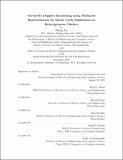On-the-fly Doppler broadening using multipole representation for Monte Carlo simulations on heterogeneous clusters
Author(s)
Xu, Sheng, S.M. Massachusetts Institute of Technology
DownloadFull printable version (11.77Mb)
Other Contributors
Massachusetts Institute of Technology. Department of Electrical Engineering and Computer Science.
Advisor
Kord S. Smith and Benoit Forget.
Terms of use
Metadata
Show full item recordAbstract
In order to use Monte Carlo methods for reactor simulations beyond benchmark activities, the traditional way of preparing and using nuclear cross sections needs to be changed, since large datasets of cross sections at many temperatures are required to account for Doppler effects, which can impose an unacceptably high overhead in computer memory. In this thesis, a novel approach, based on the multipole representation, is proposed to reduce the memory footprint for the cross sections with little loss of efficiency. The multipole representation transforms resonance parameters into a set of poles only some of which exhibit resonant behavior. A strategy is introduced to preprocess the majority of the poles so that their contributions to the cross section over a small energy interval can be approximated with a low-order polynomial, while only a small number of poles are left to be broadened on the fly. This new approach can reduce the memory footprint of the cross sections by one to two orders over comparable techniques. In addition, it can provide accurate cross sections with an eciency comparable to current methods: depending on the machines used, the speed of the new approach ranges from being faster than the latter, to being less than 50% slower. Moreover, it has better scalability features than the latter. The signicant reduction in memory footprint makes it possible to deploy the Monte Carlo code for realistic reactor simulations on heterogeneous clusters with GPUs in order to utilize their massively parallel capability. In the thesis, a CUDA version of this new approach is implemented for a slowing down problem to examine its potential performance on GPUs. Through some extensive optimization efforts, the CUDA version can achieve around 22 times speedup compared to the corresponding serial CPU version.
Description
Thesis: S.M., Massachusetts Institute of Technology, Department of Nuclear Science and Engineering, 2013. Thesis: S.M., Massachusetts Institute of Technology, Department of Electrical Engineering and Computer Science, 2013. This electronic version was submitted by the student author. The certified thesis is available in the Institute Archives and Special Collections. Cataloged from student-submitted PDF version of thesis. Includes bibliographical references (pages 107-109).
Date issued
2013Department
Massachusetts Institute of Technology. Department of Electrical Engineering and Computer Science; Massachusetts Institute of Technology. Department of Nuclear Science and EngineeringPublisher
Massachusetts Institute of Technology
Keywords
Nuclear Science and Engineering., Electrical Engineering and Computer Science.